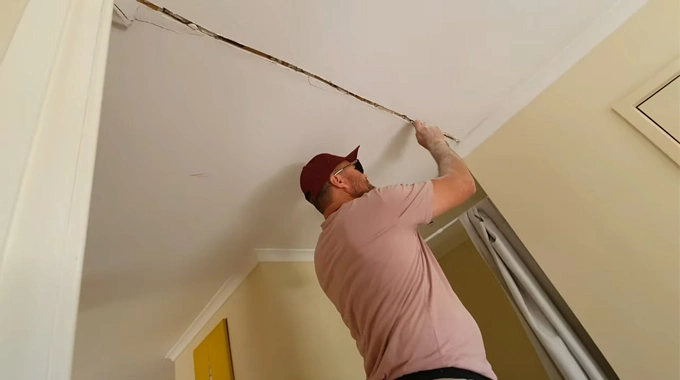Last Updated on July 30, 2023
Nobody wants to see their drywall ceiling start drooping, but it can easily happen from several sources.
From insufficient fastening of drywall sheets to pests and termites, there are all kinds of culprits that may be causing your sagging ceiling.
Poorly constructed support systems can also play a role, as well as high humidity levels in the room or simply age-related wear and tear over time.
Even roof leaks, vibrations from roller doors, poor foundations, or extra weight added through insulation layers could contribute to an unsightly drooping effect on your ceilings.
Come along on this journey of exploration to get the bigger picture behind your sagging ceiling. We’ll uncover what might have caused it in greater detail and, more importantly, how you can fix it.
Why Is My Drywall Ceiling Sagging: Causes
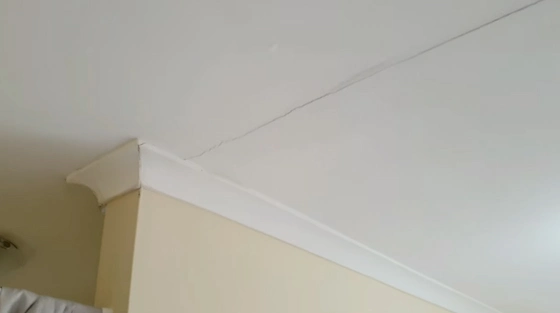
If you’re noticing your drywall ceiling starting to sag, there could be any number of reasons why. From installation woes and structural hiccups to moisture-related mishaps, pinpointing the exact cause can prove tricky. Here are a few common culprits worth exploring:
1. Poorly Constructed or Deficient Support System
A drywall ceiling often sags due to a poorly constructed or weak support system. This can include inadequate ceiling joist size, weak or incorrect attachment points for screws, and misaligned joists and framing.
Without proper support, the drywall will be unable to bear the weight of what is being placed on it and begin to sag.
Inadequate joist size can cause sagging in drywall ceilings because they cannot provide enough support to hold up the weight of whatever is placed on the ceiling surface.
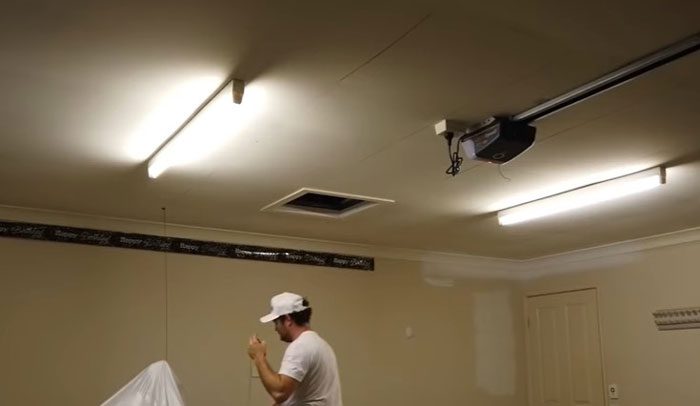
Also, improper attachment points for screws can weaken the strength of the support system. Weak connections between joists and framing members can leave them unable to bear the burden of heavier objects that are placed upon them.
Misaligned joists and framing pieces mean that they are not properly connecting with one another, leading to unequal weight distribution, which could cause structural failure and sagging over time.
2. High Humidity Levels in Room
High humidity levels in a room can also contribute to sagging drywall ceilings. When moisture retention occurs in materials such as wood, plasterboard, and concrete, it causes them to expand slightly as they absorb moisture from the air.
As these materials expand and contract over time due to changes in temperature or humidity levels, it stresses their structure, which can lead to the warping of wood joists and framing members that make up your ceiling’s support system.
This warping will weaken these components’ ability to provide adequate support for whatever you have placed upon them, resulting in sagging drywall ceilings over time.
When metal components such as nails or screws become exposed to high humidity levels, they can begin to rust, which also weakens their ability to hold up heavy objects on your ceiling surface securely. This can cause the drywall to sag due to the support system failing.
3. Overloading with Heavy Objects
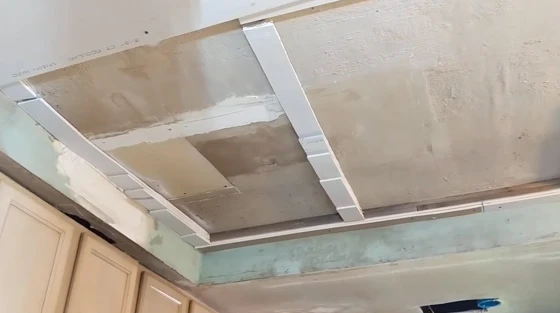
Overloading drywall ceilings with heavy objects can often lead to sagging problems because these objects add additional strain on already stressed support systems beneath them.
Placing furniture storage items etc., directly on top will cause excess stress in the particular area, potentially leading to buckling under pressure resulting in droop surface above.
It’s important to make sure no item is placed directly on the surface around the edge openings, making sure it’s secure enough not to fall off.
It’s also recommended to spread extra weight evenly distributed among available areas rather than concentrating the sole portion at any single point since it increases the chances of collapsing the entire system, taking down the entire room along the way.
4. Insufficient Fastening of Drywall Sheets
Another reason drywall ceilings may be sagging is the insufficient fastening of the drywall sheets. An adequate amount of nails or screws should be used at each wall stud junction for the sheetrock panels to remain firmly fixed in place without budging.
If too few fasteners are installed at each wall stud junction, then it’s more likely that over time with changes in humidity levels or temperature fluctuations that the sheetrock will begin shifting outwards, resulting in a sagging appearance.
Certain areas, such as corners and edges, should have additional fasteners added for extra stability since these areas require more security than other sections, making them more susceptible to movement when left unsecured.
5. Age
Over time, your drywall ceiling might sag due to age. Depending on how long ago it was installed, there could have been changes in structural strength due to factors such as moisture accumulation or changes in temperature affecting material properties (e.g., expansion).
Also, age-related degradation on any structural components involved in supporting your ceiling (such as nails/screws) will affect its durability over time. This results in weak spots that could lead to sagging issues down the line, even if all applicable code requirements were met during construction initiatives.
6. Roof Leaks
If there is a leaky roof above your drywall ceiling, this can definitely contribute to sagging as well. A leaking roof and the associated water damage may weaken the structure of the ceiling and cause it to sag significantly over time.
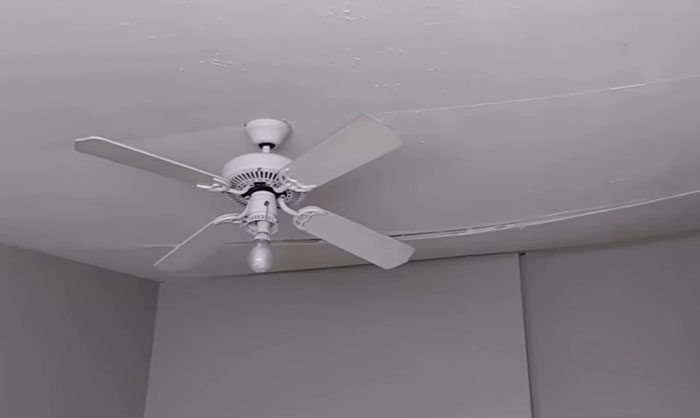
Not only does water damage weaken materials, but it also creates an ideal environment for mold growth which can quickly spread across a surface like a drywall ceiling resulting in further structural damage and weakening.
If not addressed quickly enough, a leaky roof and subsequent water damage could cause your drywall ceiling to collapse completely.
7. Vibrations from Roller Doors
Vibrations from roller doors are another potential contributor to sagging in drywall ceilings. Roller doors near your home will vibrate whenever they open or close, which can strain your drywall ceiling if it’s not secured properly.
Depending on how strong these vibrations are, they can cause screws that hold up your drywall panels to loosen over time, leading them to give way and causing sagging eventually.
For this not to be an issue, make sure all connections between your roller door and wall/ceiling are soundly secure so as not to absorb any undue vibrations that could affect your drywall over time.
8. Pests and Termites
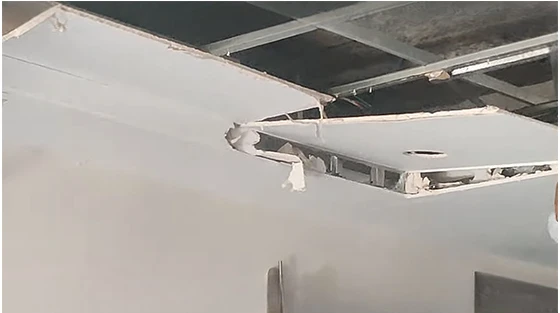
Having pests such as termites living inside the walls or ceilings of homes can also lead to sagging problems in some cases too.
Termites have been known to eat away at wooden frames used for support, particularly those made of softwood like pine. This makes them unable to support any weight placed upon them, such as a sheetrock paneling on a ceiling.
If left unchecked, a termite infestation could result in even greater ceiling damage structurally, resulting in an entire section of a room collapsing due to its weakened state caused by eating away at its supporting framework over time.
When you don’t take care of it right away, you’ll be left with only one option: to replace sections or entire rooms yourself.
9. Poor Foundations
Another possible reason for a sagging ceiling could be related to poor foundations. If there are foundation issues within your home, such as uneven floors or cracked walls, this can create additional stress points that may eventually lead to a sagging drywall ceiling over time.
Aside from that, if you live in an older home with weak joists or support beams under your floorboards and within your walls, these can also contribute to a weakened structure that makes sagging ceilings more likely.
When assessing why your drywall ceiling might be sagging, it is essential to check for any issues related to foundations around your house and within its interior spaces.
10. Weight of Insulation In the Layers
Another key factor in determining why a drywall ceiling might be sagging is related to insulation weight within its layers.
Drywalls are typically installed with insulation between each layer so that not only does this provide thermal protection but also extra structural strength against gravity pulling down on them from above.
The problem is that if you use too much insulation (or, even worse, old insulation), it can add extra weight, weakening the structure. Due to this, more pronounced sagging is seen on the walls and ceilings where heavier objects like furniture are placed on them.
Therefore when trying to diagnose why there might be abnormal movement/dropping from a particular area of the ceiling.
The existing insulation layer might be putting too much weight on this area, ultimately causing weaker structural integrity here than in other areas around it, which don’t show signs of gradual decline like this one does right now.
Can a Sagging Ceiling Collapse?

Yes, a sagging ceiling can collapse, but it depends on the severity of the problem and how it is addressed. If the sagging is not properly repaired, then it could cause a partial or full collapse of the ceiling.
Generally, when you notice signs of a sagging ceiling, such as cracks in walls or ceilings, buckling drywall, sloping floors, or even window and door frames that won’t open properly, this should be an indication that there is potential for further damage.
How Do You Fix a Sagging Ceiling Drywall?
First, if there are any issues with structural integrity, such as weakened joists or support beams, these will need to be addressed before attempting to repair the drywall itself.
Once that has been taken care of, fixing a sagging drywall ceiling involves removing all existing drywall from the area where it is beginning to sag and replacing it with new materials.
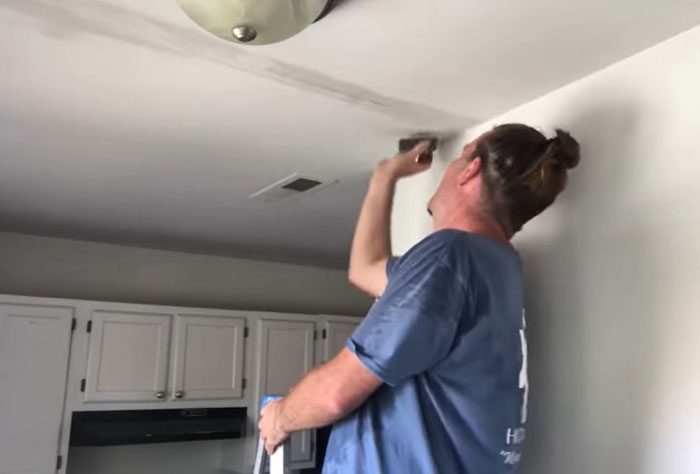
This includes cutting out any damaged pieces of wood paneling, fastening reinforcing plates into place for added stability, and then installing a new layer of drywall sheets with screws throughout for increased strength.
Besides having this work done properly and carefully by an experienced contractor to avoid injury, you might want to use heavier-duty screws when attaching your drywall to ensure it won’t weaken or get damaged if you put weighty objects on top of it again in the future.
How Much Is Ceiling Sag Acceptable?
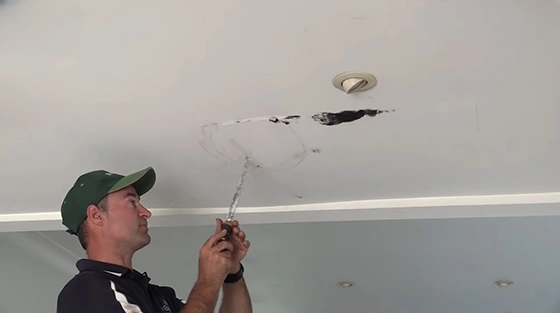
Regarding how much roof sag is acceptable, just about any amount is bad news. So preventing this type of issue from occurring should always be your main priority whenever possible.
As mentioned above, once signs of sagging become visible, they should be addressed immediately before any further damage occurs, mainly if the cause was due to water damage. This could result in mold growth which could have serious health implications if left unchecked.
Another way to prevent too much strain on your roof’s structural integrity would be to avoid placing heavy items onto your ceilings directly, no matter how sturdy they may seem.
Stay Safe With Sagging Drywall Ceiling Repair
Don’t let your drywall ceiling become a victim of neglect. Gently inspect the structure and foundation for any issues, then take steps to ensure it doesn’t fall further.
Check for pests or termites, replace old materials such as outdated sheets when necessary, and keep an eye on humidity levels in your home.
With these precautions and proper maintenance work, you can ensure this integral part of your house stays strong with no sagging worries.
